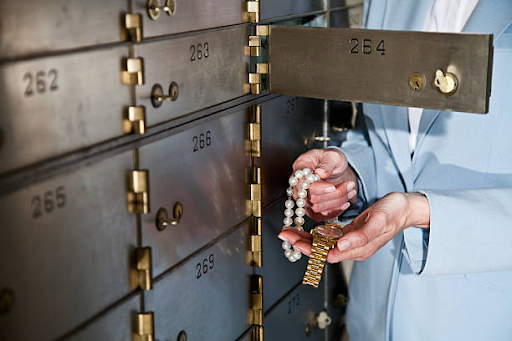In a world where wealth is often measured in gold, the need for secure storage has led to the creation of remarkable structures known as gold storage vaults. These facilities are more than just fortified rooms; they are the modern fortresses of wealth, designed to protect one of the most valuable and coveted assets in the world—gold. In this article, we will delve into the intriguing world of gold storage vaults, exploring their history, security features, and the reasons why they play a critical role in the global economy.

The History of Gold Storage Vaults
The best gold storage vault has a long and storied history that dates back centuries. The desire to safeguard valuable assets, particularly precious metals like gold, can be traced to ancient civilizations. Early attempts at secure storage included storing gold in underground chambers, hidden chambers in temples, and fortified treasury rooms within castles.
One of the most famous historical examples of gold storage is the legendary Fort Knox. Established in 1936, Fort Knox is the vault of the United States Department of the Treasury and serves as a repository for a significant portion of the United States’ gold reserves. Its construction was prompted by the economic turbulence of the early 20th century, culminating in the Great Depression. The need for a secure location to store gold became paramount, and Fort Knox emerged as the ultimate solution.
Over time, the concept of gold storage vaults has evolved to cater to the changing needs of governments, financial institutions, and high-net-worth individuals. The advent of modern technology has ushered in an era of highly sophisticated, state-of-the-art gold storage facilities.
Security Features of Gold Storage Vaults
Gold storage vaults are renowned for their unparalleled security features. These facilities are designed to deter, detect, and withstand any attempt at unauthorized access. Here are some of the key security features that define gold storage vaults:
Fortified Construction: The physical structure of a gold storage vault is built to be virtually impenetrable. Reinforced concrete walls, steel doors, and layered security zones are common elements. Vaults are often buried underground for added protection.
Biometric Access Control: Cutting-edge biometric technology is used to control access. This includes fingerprint scanning, retina recognition, and palm print identification. Only authorized individuals can gain entry.
24/7 Surveillance: Gold storage vaults are under constant surveillance. Video cameras and security personnel monitor every corner of the facility around the clock. Any suspicious activity is immediately detected and addressed.
Advanced Alarm Systems: Intrusion detection systems are equipped with state-of-the-art alarms. These alarms can be triggered by any unauthorized attempt to access the vault, including tampering with locks or doors.
Armed Security Personnel: Trained security personnel, often armed, are stationed at the facility. Their presence serves as a powerful deterrent and ensures that any security breach is met with a swift response.
Motion Sensors: Motion sensors are installed throughout the facility, capable of detecting even the slightest movement. These sensors contribute to a multi-layered security approach.
Environmental Control: Gold storage vaults maintain precise environmental conditions. These include temperature and humidity control to preserve the integrity of the gold.
Cybersecurity: In the digital age, cybersecurity is just as crucial as physical security. Vaults employ robust cybersecurity measures to protect data related to the stored assets.

The Role of Gold Storage Vaults in the Global Economy
Gold storage vaults play a pivotal role in the global economy. Their primary function is to provide a secure repository for gold, which serves as a store of value, a medium of exchange, and a hedge against economic instability. Here are some of the key ways in which gold storage vaults impact the global economy:
Reserve Asset: Central banks of countries around the world store a significant portion of their gold reserves in these vaults. Gold is considered a “reserve asset” and is used to support a nation’s currency and financial stability.
Wealth Preservation: High-net-worth individuals and families rely on gold storage vaults to preserve and protect their wealth. Gold is seen as a stable asset that can withstand economic fluctuations.
International Trade: Gold is often used in international trade. Its secure storage in these facilities ensures the integrity of transactions and financial settlements.
Financial System Stability: The presence of gold reserves in vaults contributes to the stability of the financial system. In times of economic crisis, gold serves as a valuable asset that can be used to address liquidity issues.
Historical Significance: Some gold storage vaults, like Fort Knox, hold historical and symbolic significance. They are a testament to a nation’s economic strength and commitment to safeguarding its wealth.
Confidence and Trust: The existence of secure gold storage facilities fosters confidence and trust in the global financial system. It assures investors, governments, and financial institutions that their assets are safe.
Choosing a Gold Storage Vault
For individuals or institutions considering gold storage, several factors come into play:
Location: The choice of a vault’s location can be important. Some may prefer facilities in politically stable regions, while others prioritize proximity to financial centres.
Security: Investigate the security features and reputation of the vault. Independent audits and compliance with industry standards are indicators of reliability.
Accessibility: Consider how easy it is to access the vault when needed. Some vaults offer on-demand access, while others may have more restrictive protocols.
Cost: The cost of storing gold in a vault is a crucial consideration. Fees may vary based on the amount of gold stored and the services provided.
Insurance: Assess the insurance coverage provided for stored assets. It’s essential to understand the extent of coverage and any additional costs.
Conclusion
Gold storage vaults stand as the guardians of one of the world’s most precious assets. They are more than just structures; they are the embodiment of security, trust, and the enduring value of gold. With their fortified construction, advanced security systems, and critical role in the global economy, gold storage vaults are more relevant than ever. They represent a tangible testament to the significance of gold as a symbol of wealth and stability. Whether safeguarding the reserves of nations or preserving the riches of individuals, these modern fortresses of wealth play a critical role in securing a brighter financial future.
